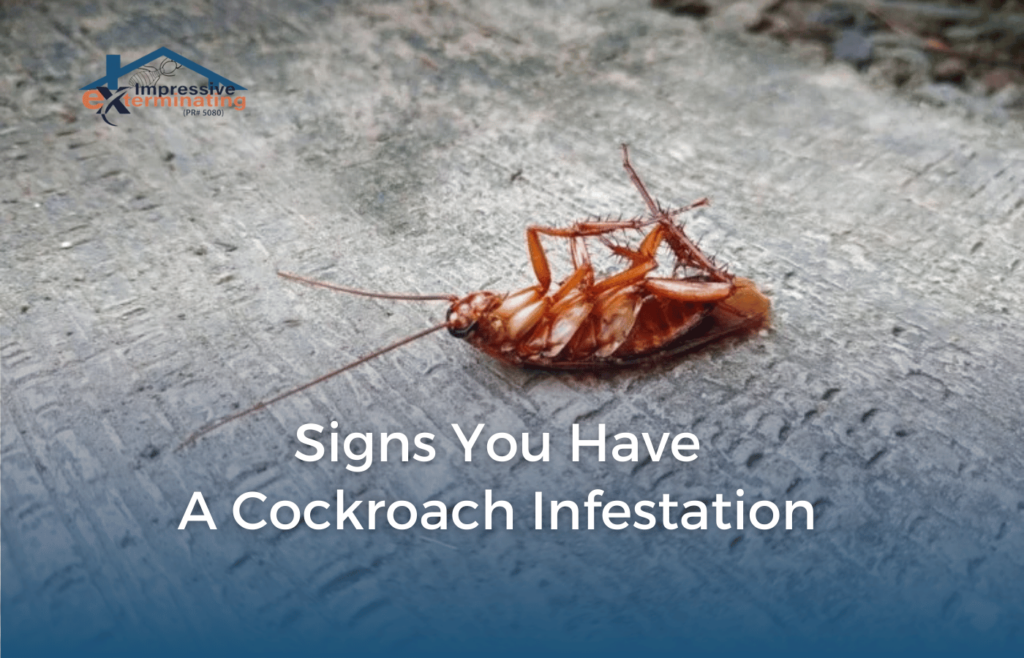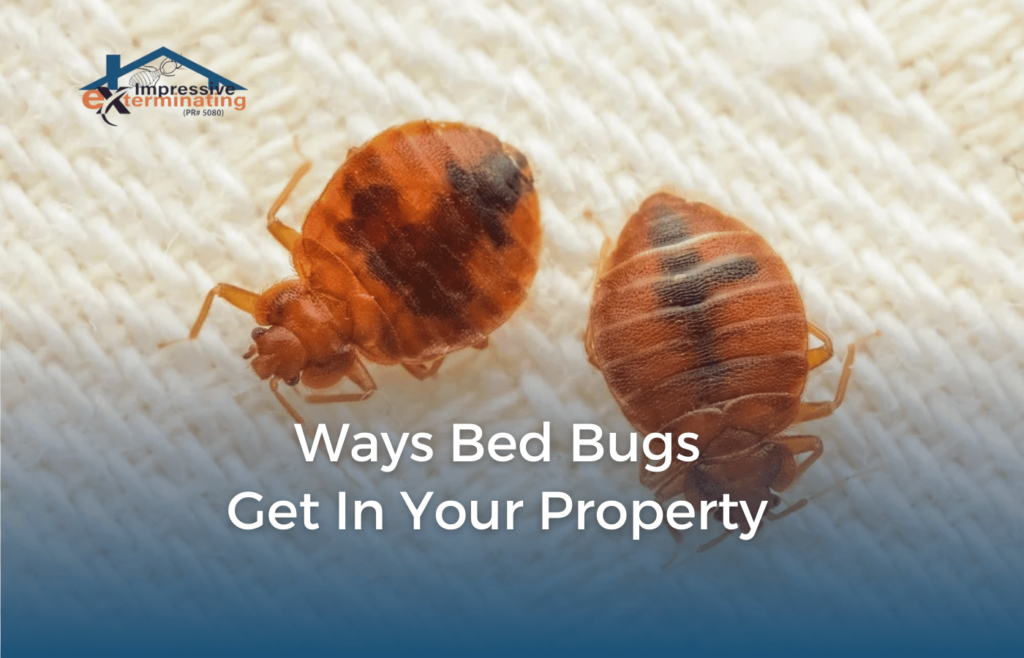Signs You Have a Cockroach Infestation

Living in sunny Southern California brings many perks, but it also comes with unwanted houseguests sneaking into your homes. Among these uninvited visitors, cockroaches rank as some of the most troublesome pests. Many people are surprised when they learn about the initial signs of roach activity because these crafty insects stay hidden during daylight hours. Understanding early warning signs can help you tackle these sneaky critters before they multiply and become a full-blown pest infestation. Droppings Around Your Home Roach droppings look similar to coffee grounds or black pepper specks scattered near their favorite hiding spots, including kitchen cabinets, beneath kitchen sinks, and behind appliances. German cockroaches, which commonly infest Southern California homes, leave behind tiny droppings measuring about 1 millimeter in size. Larger American cockroaches produce bigger droppings reaching 2-3 millimeters. Fresh droppings appear dark and moist while older ones look gray and crumbly. Either way, finding numerous droppings indicates multiple roaches living nearby because each bug produces several droppings daily. You’ll want to pay extra attention near food storage areas since these pests love hanging out where they can grab midnight snacks. Unusual Smells in Your Living Space A strong, musty odor often accompanies roach infestations. This distinctive smell comes from chemicals roaches release while communicating with each other. Many people describe this scent as oily or somewhat sweet yet incredibly unpleasant. Different roach species produce varying smells, but most California residents describe their odor as similar to that of dirty gym socks or moldy food. This smell grows stronger as roach populations increase inside your home. When numerous roaches gather in enclosed spaces, their collective scent becomes quite noticeable, especially in kitchen areas or bathrooms. Physical Evidence of Roach Activity Beyond droppings, cockroaches leave behind other clear signs of their presence. Empty egg cases called oothecae appear tan or dark brown and measure roughly 8 millimeters long. Female roaches typically hide these cases in protected spots like corners, cracks, or beneath furniture. Shed skins provide another telltale sign because roaches molt several times while growing. These translucent shells look like pale versions of actual roaches. Finding multiple shed skins suggests an active infestation happening inside your home. Damage to Food Packages and Other Items Hungry roaches chew through cardboard, paper, and thin plastic packaging to reach food inside. Check your pantry for small holes or tears in food containers, especially cereals, grains, and pet food bags. These resourceful pests also nibble on book bindings, wallpaper, and even soap bars when seeking nutrition. In severe cases, roaches damage electrical wiring by eating through protective coatings. This behavior creates serious fire hazards requiring immediate professional attention. Aside from the usual areas, cockroaches can do extensive damage behind walls and under floorboards. Live Roach Sightings Seeing live roaches during daytime hours suggests a significant infestation because these nocturnal insects usually hide until dark. Desperate roaches venture out during daylight when populations grow too large for available hiding spots, or food becomes scarce. Prevention and Professional Help Maintaining clean surfaces, sealing food properly, and fixing water leaks helps discourage roach activity. However, established infestations require professional pest control services because these resilient insects reproduce rapidly while hiding in hard-to-reach places. Local pest control experts serving Los Angeles, Long Beach, and Orange County understand regional roach species and their habits. They utilize safe, effective treatments targeting problem areas while protecting your family and pets. Quick action prevents small problems from expanding into major headaches requiring extensive treatments. Remember that seeing one roach likely means many more lurk nearby since these social insects live in groups. Don’t wait until problems escalate before seeking help. Early intervention with the help of pest control experts saves time, money, and stress when dealing with these persistent pests.
Ways Bed Bugs Get In Your Property

Living around Los Angeles, Longbeach, or Orange County leaves nobody safe from unwanted bed bug visitors. These sneaky creatures find creative paths into homes throughout the tourist-filled Southern California. Knowing how bed bug infestations can start can help you stay alert and watchful. Through Travel Activities Frequent travelers face higher risks of bringing bed bugs home. These tiny hitchhikers love hiding in luggage, purses, and backpacks. Hotels and inns across California often harbor bed bugs, requiring thorough cleaning. Placing suitcases on hotel beds or carpets creates the perfect opportunity for bed bugs. It’s wise to check the hotel mattresses before unpacking or leaving. You’ll also want to check your luggage before going home so you don’t bring bed bugs inside. Used Furniture Adventures Getting second-hand furniture seems budget-friendly, but it carries hidden dangers. Old couches, mattresses, or chairs might contain bed bug colonies, which explains two things: their low, often-free price and why no one seems to want them. Bed bugs naturally gravitate toward fabric surfaces with many hiding spots. But if you insist, carefully examining used items before purchase can save money and prevent infestations. Look inside seams, beneath cushions, and around wooden joints. Neighboring Units Apartment dwellers face unique challenges with bed bugs. These persistent pests travel through walls, electrical outlets, and shared ventilation systems. Don’t underestimate how many problems a single infested unit can cause to multiple homes nearby. Bed bugs crawl through tiny wall cracks, searching for food sources. Regular inspections done by pest control experts help catch early warning signs before problems worsen. Moving Day Troubles You might not know it, but you might be bringing unexpected guests along when you have between homes. Moving boxes left stored in infested garages or storage units become perfect vehicles for bed bugs. The cardboard materials provide excellent hiding places during transport. Consider using plastic bins instead of regular boxes when moving belongings. Public Transportation Adventures Daily commuters on buses or trains around Orange County risk picking up bed bugs. Public seating areas often harbor these unwanted passengers, especially since they aren’t cleaned thoroughly often if at all. Like infested furniture, the fabric seats provide cozy spaces where bed bugs wait for new hosts. Keep personal items off shared seats whenever possible. School and Work Connections Children attending school or adults working in office buildings might unknowingly transport bed bugs. Backpacks, laptop bags, lockers, coat closets, and the constant movement of people create the perfect hiding spots. These pests can move between buildings by clinging onto personal belongings. Laundromat Surprises Community washing facilities sometimes spread bed bugs between customers. Shared laundry baskets or folding stations might harbor insects. Always transport clothes in sealed plastic bags. Fortunately, using hot water and high-heat drying cycles kills most bed bugs. Package Deliveries Online shopping brings convenience but sometimes unexpected guests, too. Unsanitary warehouse storage conditions might expose packages to bed bugs. These resourceful insects squeeze into small spaces during shipping. Carefully inspect delivered boxes outside before bringing them indoors. Social Gatherings Visiting friends or hosting parties creates opportunities for bed bug transfers. These insects can ride on coats, bags, or shoes. Large and frequent social gatherings increase the chances of encountering affected items. Prevention Tips Regular property inspections catch early warning signs. As a homeowner, you should look for small brown spots on mattresses or furniture. Install bed bug interceptors under furniture legs. Keep sleeping areas away from walls when possible so they aren’t easily accessible, and make sure that you vacuum frequently, especially around baseboards and furniture. But remember that bed bugs affect all neighborhoods. An infestation isn’t necessarily a sign of living in unsanitary conditions. Quick action after spotting signs prevents significant problems. Professional and local pest control services understand the behavior patterns of bed bug infestations within the area. They can provide targeted solutions for Southern California properties. If suspicious signs of bed bugs appear, contact a bed bug exterminator immediately.
Top Diseases Pests Can Spread

Living in Los Angeles, otherwise known as the City of Angels, means dealing with unwanted guests year-round. Our 30 years of pest control experience across Southern California reveals how these tiny invaders affect family health. Let’s explore what diseases different pests carry and why quick action matters for your safety. Rodent-Related Health Threats Mice and Rat Diseases Those little footsteps in your attic signal bigger problems. Hantavirus spreads when people breathe dried mouse-dropping particles. LA homes frequently face this risk through dust during cleaning. Rat urine carries Leptospirosis, which enters human bodies through minor skin cuts or contaminated water sources. Hidden Dangers of Rodent Infestations But that’s not all. Rodents also leave invisible trails of bacteria everywhere they go. Their constant nibbling contaminates food storage areas. Baby mice produce droppings resembling dark rice grains but carrying dangerous germs. Professional pest control becomes crucial when dealing with these health risks. Crawling Creatures and Their Diseases Cockroach Health Hazards These sneaky insects bring numerous health problems into California homes. Salmonella bacteria live on roach legs and bodies, making every surface they touch potentially dangerous. Children develop asthma more frequently in roach-infested houses due to allergens from dead bugs and droppings. Ant-Related Problems Sweet-seeking ants contaminate food supplies throughout LA kitchens. Carpenter ants damage wooden structures, while fire ants deliver painful stings. Although they rarely spread severe diseases, their presence indicates sanitation issues needing immediate attention. Flying Pests and Disease Transmission Mosquito-Borne Illnesses Southern California’s warm climate keeps mosquitoes active almost forever. West Nile virus spreads through female mosquito bites across LA neighborhoods. Saint Louis encephalitis appears during summer months when mosquito populations peak. Both conditions cause severe flu-like symptoms requiring medical care. Dangers From Birds Pigeons and other birds create health hazards through their droppings. Histoplasmosis develops from breathing fungal spores in bird waste. Cryptococcosis threatens people cleaning bird-populated areas without proper protection. Both infections need serious medical treatment. Blood-Feeding Pests Tick-Related Diseases California outdoor activities expose people to tick bites. Lyme disease threatens hikers and gardeners across LA County. Rocky Mountain spotted fever requires quick medical attention after tick exposure. Early detection makes treating these conditions much easier. Flea Problems Pet owners face special challenges with fleas jumping between animals and humans. Murine typhus occurs regularly in LA neighborhoods through infected flea bites. Cat scratch disease spreads when flea dirt enters small wounds. Regular pet treatment helps prevent these issues. Prevention and Protection Keeping Your Home Safe Good cleaning habits make huge differences in pest control success. Proper food storage prevents attracting unwanted visitors. Fixing leaky pipes removes water sources that pests need. Sealing entry points stops new infestations before they start. Professional Solutions DIY methods often provide temporary relief but miss underlying problems. Expert pest control services understand local species behaviors. Targeted treatments offer longer-lasting protection against disease-carrying pests. Regular inspections catch problems early when solutions work better. Taking Action LA residents should watch for signs of pest activity in their homes. Quick responses prevent small problems from growing bigger. Different seasons bring varying pest challenges but maintaining vigilance helps protect family health year-round. Professional pest management creates stronger barriers against unwanted intruders. Our extensive experience across Los Angeles provides a deeper understanding of local pest patterns. Working together ensures healthier living spaces free from disease-carrying pests and their associated risks. Remember that effective pest control requires understanding which creatures cause problems in our area. Los Angeles pest control experts know how best to handle specific species. Partnership between homeowners and professionals leads to better results in managing pest-related health risks.
The Types of Termites in California

Various termite species make their homes throughout the United States, but California is one of the worst places for property owners termite-wise. Understanding these wood-eating insects can help you protect your investments. This guide explores different termite types in the Bear Flag State. Common Termite Species in California Subterranean termites rank among California’s most widespread wood destroyers. These busy insects build mud tubes between soil and wooden structures. A mature colony might contain thousands of members, most of which will be underground. The worker termites measure roughly 1/8 inch long with cream-colored bodies. Soldiers sport larger heads with strong jaws to protect their nest mates. Drywood termites prefer setting up colonies directly inside wooden items without ground contact. Unlike their subterranean cousins, these termites don’t need soil moisture for survival. Small colonies often hide within furniture, structural beams, or wooden decorations. Their pellets look like tiny grains of sand or pepper scattered near infested wood. The third kind, damp wood termites, gravitate toward moist, decaying wood in natural settings. These larger insects measure up to 1 inch long and have reddish-brown coloring. Though less common inside buildings, damp wood termites occasionally infest structures with water damage or wood-to-ground contact. Identifying Different Termite Types Recognizing termite species helps determine appropriate termite control methods. For starters, subterranean termites leave behind distinctive mud tubes along foundation walls or between soil and wood. Their workers also appear smaller than other species with soft, light-colored bodies. In comparison, dry wood termites create small, clean-cut holes in wood surfaces. Their distinctive pellets accumulate below infested areas, resembling piles of coarse sand. Swarmers measure about 1/2 inch long, including wings, and show up during warm summer evenings or early fall. Finally, you can tell damp wood termites from other types because they leave behind moist, damaged wood with tunnel patterns following grain direction. Their larger size makes them easier to spot during inspections. Regional Distribution Across California Different termite species prefer specific California regions based on climate and environmental conditions. Subterranean termites thrive throughout most areas but are abundant in central valleys and coastal regions, with increased activity during warmer months. Drywood termites concentrate heavily along coastal areas from San Diego through San Francisco. Moderate temperatures and humidity levels create ideal conditions for these wood-dwelling insects. Interior regions experience fewer dry wood problems except in climate-controlled buildings. Dampwood termites commonly appear in northern California forests and coastal areas receiving higher rainfall. These moisture-loving insects only establish themselves in drier inland regions if artificial conditions support their needs. Natural habitats include rotting logs, stumps, and living trees with decay. Seasonal Activity Patterns Subterranean termites show increased surface activity during spring months when temperatures warm. Meanwhile, drywood termites often swarm during late summer through early fall months. Dampwood termites generally swarm during the late summer months, coinciding with seasonal moisture changes. Their activity levels fluctuate based on environmental conditions rather than strict seasonal patterns. Consistently damp conditions support year-round activity in suitable locations. Prevention and Management Strategies Protecting properties against termite invasion requires understanding each species’ unique characteristics. Regular inspections help detect early signs before extensive damage occurs. Professional pest control experts can identify specific species and recommend appropriate treatment methods. Reducing moisture problems discourages both subterranean and damp wood termites, and sealing entry points helps prevent dry wood termite infestations. Professional whole-house treatments provide longer-term protection when needed. Investing in early intervention saves money by preventing extensive structural damage. Despite their reputation as pests, termites serve important ecological functions in natural settings. These insects help decompose dead plant material, returning nutrients into soil systems. Their tunneling activities improve soil structure and water penetration in outdoor environments. Working with qualified pest control professionals is the best way to guarantee proper treatment of identified species.
Effective Pest Control Strategies for Los Angeles Residents

The Importance of Pest Control in Los Angeles Pest control is a crucial aspect of maintaining a healthy living environment in Los Angeles. The diverse climate and geography create prime conditions for various pests, including rodents and termites. These nuisances can disrupt homes, impacting both comfort and health. Effective pest management ensures that both residents and their properties remain safe and pest-free. Rodent Control: Keeping Your Home Safe Rodents are one of the most common pests encountered in Los Angeles. These critters not only pose a nuisance but can also lead to severe health risks. Implementing proper rodent control measures involves a combination of sanitation, exclusion, and, if necessary, the use of traps or professional pest control services. Regular inspections can help identify problem areas and take proactive steps against infestations. Termite Treatment: Protecting Your Home Investment Termites are another significant concern for homeowners in Los Angeles. These pests can cause extensive damage to wooden structures if left untreated. Early detection is key to effective termite treatment. Homeowners should consider regular termite inspections and preventive treatments, especially in high-risk areas. Investing in professional pest control services can provide peace of mind and safeguard your property. By addressing both rodent control and termite treatment, residents can protect their homes from the perils of pest infestations.

